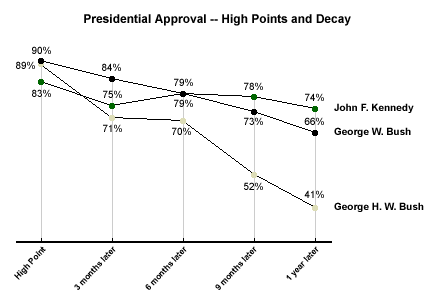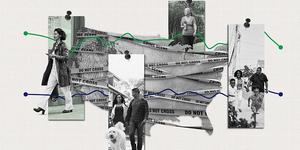Just weeks after the terrorist attacks in New York and Washington, a Sept. 21-22, 2001, Gallup Poll found President George W. Bush with a 90% job approval rating, the highest rating recorded in Gallup's polling history on this question dating back to 1938. Bush was able to sustain this high rating for quite some time, but it has shown inevitable decline over the last year. The latest measurement on Bush approval, from a Sept. 20-22, 2002, poll*, finds his approval rating at 66% -- a drop of 24 points since this time last year.

Bush's approval rating has shown a fairly constant decay in the past year, losing about six points every three months. He was able to stay within five percentage points of his high for an amazing 16 weeks, not falling below 85% until January 2002. Previous presidents who benefited from this type of "rally effect" saw much more rapid decline from their high approval ratings, typically in as little as one to four weeks. Lyndon Johnson had previously been able to sustain his high approval rating the longest, but it took just seven weeks for his 79% rating (which he achieved early in 1964 several months after the assassination of John F. Kennedy) to fall to 74%.
Only two other presidents have ever received approval ratings higher than 80%: Kennedy in April-May 1963 (83%) and George H.W. Bush in February-March 1991 (89%). The current president's approval rating has shown slightly more decline than Kennedy's, whose approval rating fell 20 points within a year, but significantly less than his father's, which was down 48 points to 41% a year after the U.S. victory in the Persian Gulf War.

For his term to date, Bush has averaged a 70% approval rating, the same that Kennedy averaged from 1961-1963, and the highest among presidents dating back to Harry S. Truman. Dwight D. Eisenhower has the next highest term average at 65%, followed by the elder Bush at 61%.
*Results are based on telephone interviews with 1,010 national adults, aged 18 and older, conducted Sept. 20-22, 2002. For results based on the total sample of national adults, one can say with 95% confidence that the maximum margin of sampling error is ±3%.
